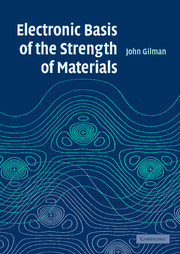Book contents
- Frontmatter
- Contents
- Preface
- Section I Introduction
- Section II Elements of solid mechanics
- Section III Elements of electron mechanics
- 5 Properties of electrons
- 6 Quantum states
- 7 Periodic patterns of electrons
- 8 Heisenberg's Principle
- Section IV Elastic stiffness
- Section V Plastic strength
- Section VI Fracture resistance
- Index
- References
5 - Properties of electrons
Published online by Cambridge University Press: 14 August 2009
- Frontmatter
- Contents
- Preface
- Section I Introduction
- Section II Elements of solid mechanics
- Section III Elements of electron mechanics
- 5 Properties of electrons
- 6 Quantum states
- 7 Periodic patterns of electrons
- 8 Heisenberg's Principle
- Section IV Elastic stiffness
- Section V Plastic strength
- Section VI Fracture resistance
- Index
- References
Summary
About 250 years ago, through his mastery of the technology of Leyden jars, Benjamin Franklin, and his research group, discovered one of the most important characteristics of electricity; namely, the charge associated with it is conserved. He reached this conclusion in 1749 when he found that whenever a quantity of charge is taken from a Leyden jar, the charge stored in the jar is reduced by an equal quantity, so the total charge remains constant. He thought of electricity as a continuous fluid of charged particles able to pass through some liquids (e.g., water) and some solids (e.g., metals), but not others (e.g., glass). He identified positive and negative states of charge, one associated with an excess of the electrical fluid, and the other with a deficit of it. His studies were qualitative because there were no adequate instruments for making measurements, but the ingenuity of the studies established his genius. He knew that the force between equal charges declines rapidly with the distance between them, that the resistances of wires increase with the length and inversely with the cross-sectional area, also that electricity passing through a resistive solid generates heat (Cohen, 1941).
Regarding the “electric fluid” contained in glass, Franklin commented (Schonland, 1956), “It seems as if it were of its very substance and essence. Perhaps if that due quantity of electrical fire so obstinately retained by glass could be separated from it, it would no longer be glass. Experiments may possibly be invented hereafter to discover this.”
- Type
- Chapter
- Information
- Electronic Basis of the Strength of Materials , pp. 31 - 36Publisher: Cambridge University PressPrint publication year: 2003



